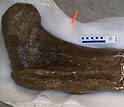News Release 05-085
Geologists Find First Clue to T. rex Gender in Bone Tissue
Lucky break reveals it's a girl

Two Tyrannosaurus rex adults are alert and ready to hunt.
June 2, 2005
This material is available primarily for archival purposes. Telephone numbers or other contact information may be out of date; please see current contact information at media contacts.
In a literal "lucky break" that exposed unusual bone tissue lining the hollow cavity of a Tyrannosaurus rex leg bone, paleontologists at North Carolina State University have determined that a 68 million-year-old T. rex fossil from Montana is that of a young female, and that she was producing eggs when she died.
In a report published in the June 3, 2005, issue of the journal Science, Mary Schweitzer, a paleontologist at NCSU and the North Carolina Museum of Natural Sciences, and her colleagues state that the presence of this particular tissue provides evidence of the dinosaur's gender, and a connection between dinosaurs and living birds.
Schweitzer believes the unusual tissue inside the bone is medullary bone: a thin layer of highly vascular bone that is found in present-day female birds only during ovulation. This estrogen-linked reproductive bone tissue forms inside the hollow leg bones of the birds and persists until the last egg is laid, at which time it is completely resorbed into the bird's body. Its formation is triggered by an increase in estrogen levels, and the temporary tissue provides the calcium necessary to form eggshells.
"The discovery of medullary bone in T. rex is important because it allows us to figure out the gender of a dinosaur," says Schweitzer. "It also adds to the support linking birds and dinosaurs, and shows that their reproductive physiologies may have been similar. We hope to be able to identify features in dinosaurs that will help determine the gender of other fossils, and lead to information about their herd structure or family groups."
Medullary bone is only found in present-day female birds; no other egg-laying species (including crocodiles, the other living dinosaur relative) produces the tissue naturally.
"Schweitzer's recognition of medullary tissues in T. rex is very important because it indicates a close relationship between dinosaurs and birds," said Enriqueta Barrera, program director in the National Science Foundation (NSF)'s earth sciences division, which funded the research. "Birds and dinosaurs may have mobilized calcium and shelled their eggs in a similar manner. The discovery also provides us with the means to identify gender in dinosaurs."
Because the dinosaur tissues didn't look exactly like pictures published of medullary bone in living birds like chicken and quail, Schweitzer's team compared the tissue from the femur of the T. rex to that taken from leg bones of more primitive ratites, or flightless birds, such as ostriches and emus. These birds share more similar features with dinosaurs than do other present-day birds. An ostrich and an emu in different stages of their laying cycles were selected, at times when medullary bone was present.
Schweitzer analyzed the tissues and found that the dinosaur material was virtually identical to that of the modern birds in form, location and distribution. Removal of the bones' minerals revealed that medullary bone from the ostrich and emu was virtually identical in structure, orientation and even color, with that of the T. rex.
Since only females produce medullary bone, its presence in the T. rex femur indicates that this fossil was a female, and probably one who died toward the end of her laying cycle. "From a biological perspective, the tissue is another link between dinosaurs and living birds," said Schweitzer.
-NSF-
-
Tissue within T. rex bone led to a determination of the dinosaur's gender.
Credit and Larger Version
Media Contacts
Cheryl L. Dybas, NSF, (703) 292-7734, email: cdybas@nsf.gov
The U.S. National Science Foundation propels the nation forward by advancing fundamental research in all fields of science and engineering. NSF supports research and people by providing facilities, instruments and funding to support their ingenuity and sustain the U.S. as a global leader in research and innovation. With a fiscal year 2023 budget of $9.5 billion, NSF funds reach all 50 states through grants to nearly 2,000 colleges, universities and institutions. Each year, NSF receives more than 40,000 competitive proposals and makes about 11,000 new awards. Those awards include support for cooperative research with industry, Arctic and Antarctic research and operations, and U.S. participation in international scientific efforts.
Connect with us online
NSF website: nsf.gov
NSF News: nsf.gov/news
For News Media: nsf.gov/news/newsroom
Statistics: nsf.gov/statistics/
Awards database: nsf.gov/awardsearch/
Follow us on social
Twitter: twitter.com/NSF
Facebook: facebook.com/US.NSF
Instagram: instagram.com/nsfgov



